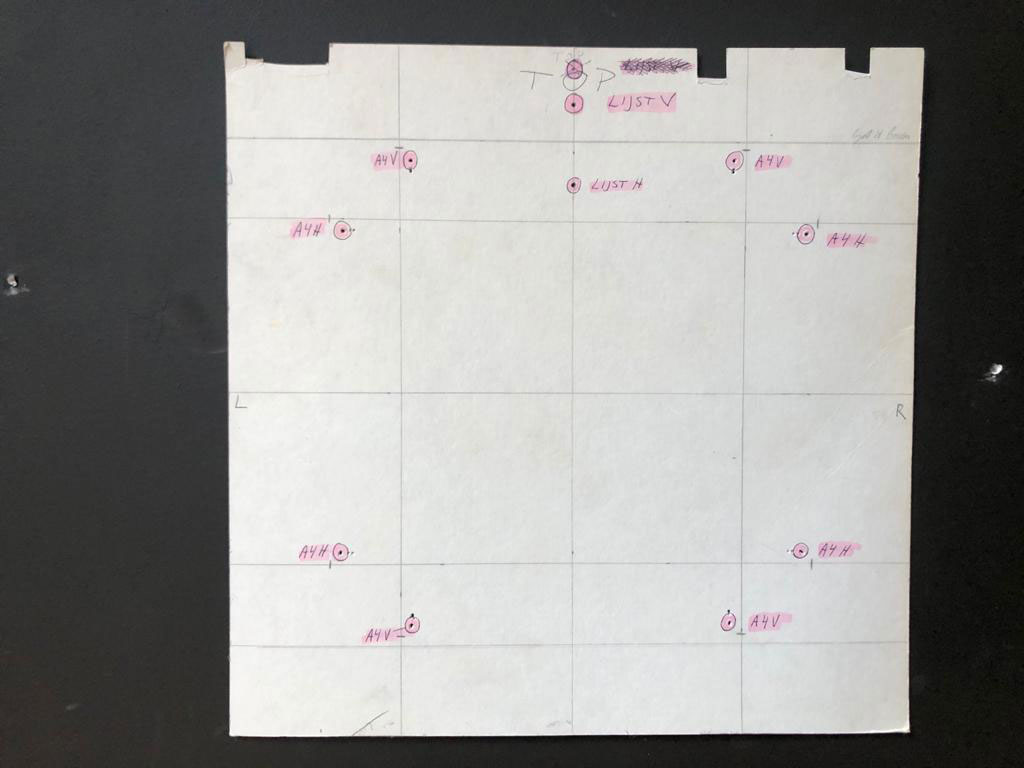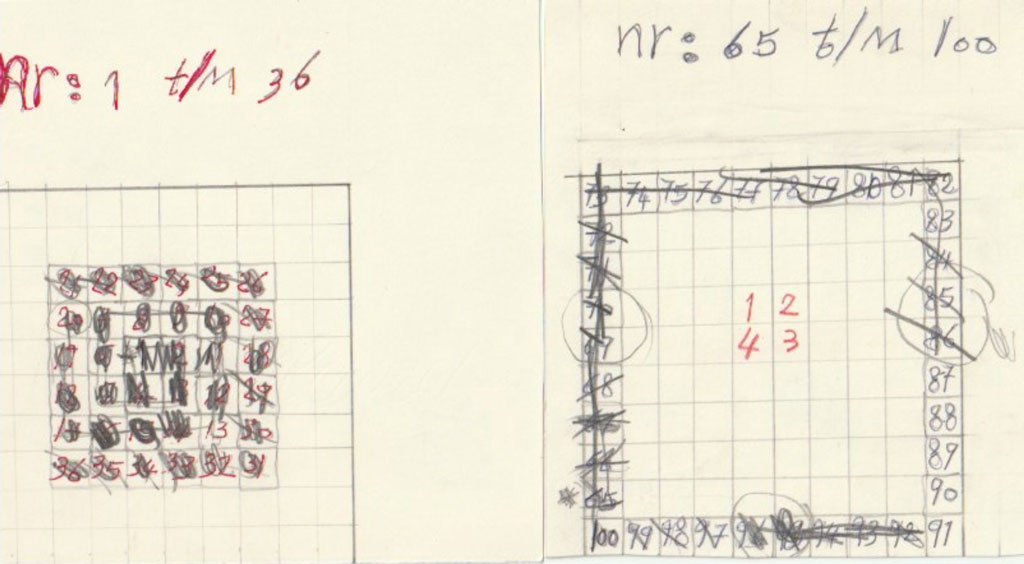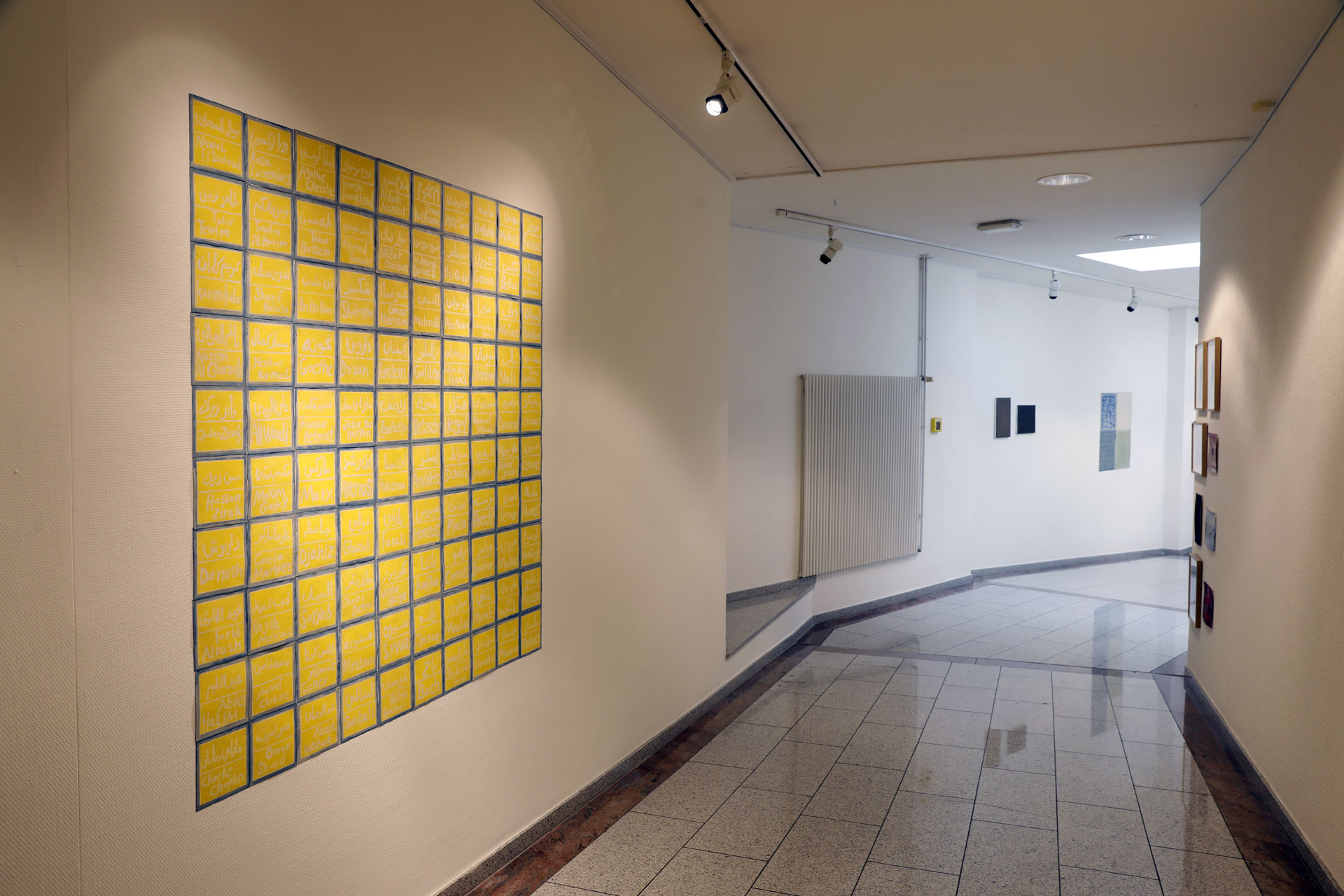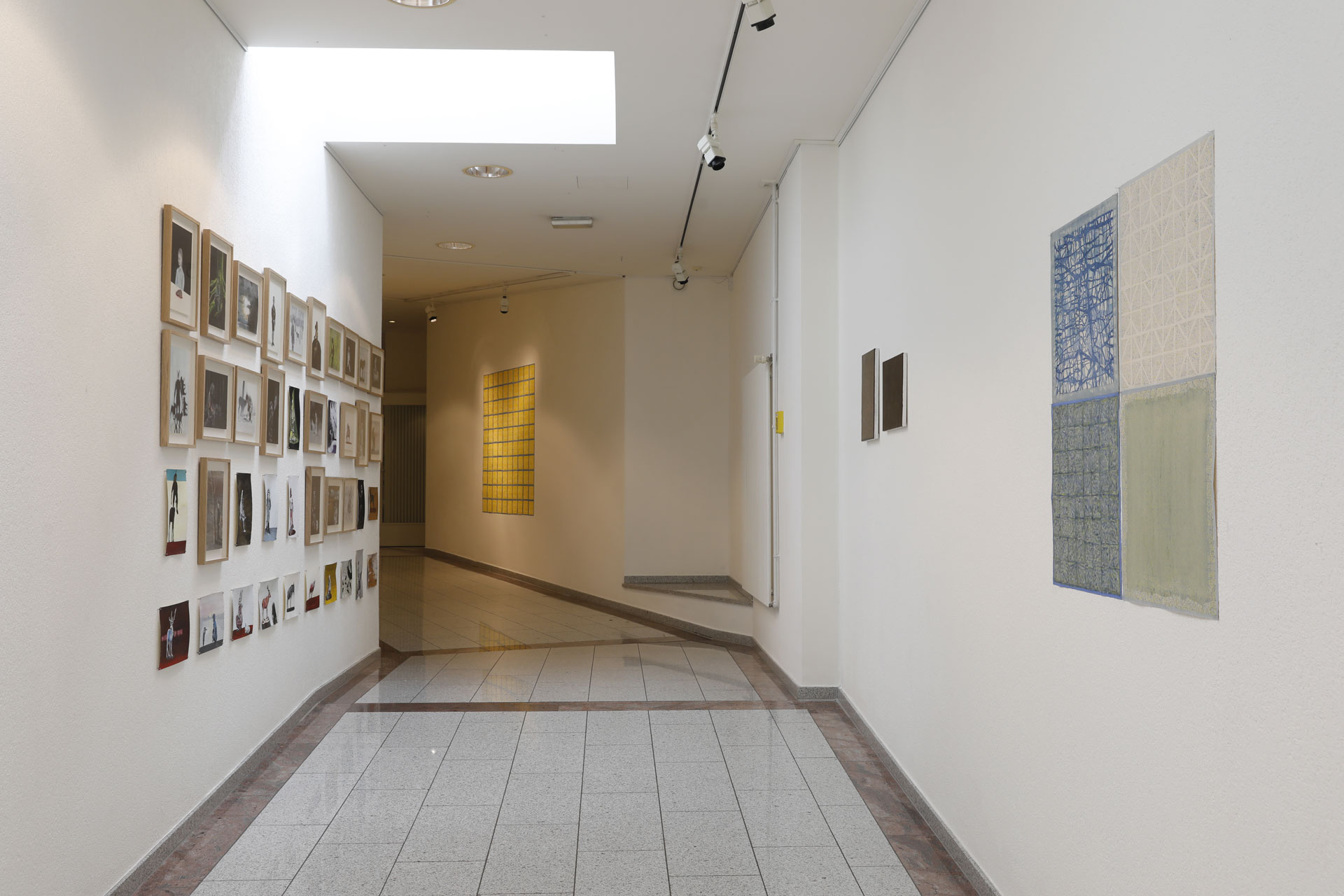Passages en Passant #1:
Fatima Barznge & Mirjam Somers
Juni 18 – Juli 17, 2021
Het interview
(english below)
Eva Visser
Dit interview poogt inhoudelijk aan te sluiten bij de opzet van de curatoren van Passages en passant: het faciliteren van een ontmoeting tussen het werk van twee kunstenaars in de bijzondere tentoonstellingsruimte in de gang van het Goethe-Institut. Mijn vragen betroffen daarom vooral de interactie tussen de kunstenaars, hun interactie met de ruimte – en de plaats van elkaars werk daarin – en de interactie van de bezoekers met de kunstwerken. Het interview is vormgegeven als een tweegesprek waarin de kunstenaars elkaar aanvullen.
F: Kathrin [Wolkowicz] vroeg mij voor deze expositie – en als Kathrin mij vraagt dan zeg ik gelijk ‘ja’. Ik zeg sowieso weinig ‘nee’, want het is altijd een eer als mensen je werk willen tonen. Ze vroeg me het grote, gele werk [Study of Square / To my generation] te tonen. Dit werk heb ik één keer eerder getoond, in galerie Sanaa in Utrecht, en toen is het verkocht. Voor deze expositie heb ik het geleend. Ik heb dit werk aangevuld met ander werk dat ik voor deze expositie geschikt vond. Het achterliggende idee achter al het werk dat ik maak is hetzelfde – het gaat altijd over de verbinding van waarneming en herinnering.
M: Marco [Douma] vroeg mij werk uit de serie Daily Drawings te tonen. Deze serie tekeningen is tot stand gekomen tijdens de lockdown. Iedere dag heb ik er één gemaakt en door de gemoedstoestand van die dag bracht iedere dag toch een nieuwe manier van tekenen. Het doel van het project was mezelf ruimte te geven en per dag te kijken wat er kwam. De meeste werken zijn figuratief, maar sommigen zijn meer abstract of bevatten tekst – fluisteringen. Toen ik werd uitgenodigd heb ik Fatima’s werk opgezocht; ik kende haar naar niet, maar veel mensen om me heen wel. De ruimte [in de gang bij het Goethe-Institut] kende ik ook nog niet.
F: Ik kende deze plek al wel: vrienden van me zijn er tentoongesteld. En ik heb veel met zowel de plek als de naam. Ik heb goede herinneringen aan de naam Goethe door zijn boek Faust. Het Goethe-Institut heeft ook locaties in mijn geboorteland Irak die heel actief en heel gewaardeerd zijn voor actuele kunst en cultuur. Hier vind ik alles leuk aan het Institut: de sfeer tijdens openingen, de mensen die er werken. Mirjam’s werk kende ik nog niet, maar mijn vriend, die ook kunstenaar is, kende haar werk al wel. Toen ik foto’s van haar laatste werk online had bekeken besloot ik dat de samenwerking leuk zou zijn.
M: Fatima heb ik bij mij thuis uitgenodigd om de tentoonstelling van Daily Drawings #100-200 te zien. Haar werk vond ik meteen mooi, al staat het wat verder af van mijn werk. Omdat ik zowel haar werk als de architectuur van de [tentoonstellings]ruimte interessant vond zei ik volmondig ‘ja’ tegen de uitnodiging. De timing was ook mooi: ik kon hier kijken of mijn werk de wereld in kon – de eerste stap naar buiten is altijd spannend.
M: Onze eerste kennismaking was hier, met z’n vieren. Marco en Kathrin hadden ieder één van ons aangedragen en afgesproken dat ze de ontmoeting tussen ons – en tussen ons werk – vrij zouden laten. Dit tentoonstellingsproject gaat ook over hun dialoog en de ruimte die zij elkaar willen geven. We hebben samen de ruimte bekeken; deze biedt alle richtingen: dalend naar beneden en omhoog naar het licht. Ik wilde meteen de muur die ik heb gekregen vanwege die gekke knik – door die knik is de ruimte naar boven, naar het daglicht gericht.
F: Mensen zeiden: “je werk is aangekocht door musea en nu ga je het in een gang ophangen”, maar het is de mooiste gang die ik ooit gezien heb. Voor het grote, gele werk (van anderhalf bij anderhalve meter) wilde ik een niet te grote muur, een muur die een beetje gekaderd zou zijn. Ik had deze plek al in gedachte als een goede plek voor dit werk en daarom vond dit werk eerst zijn plek.
M: Ik maakte me zorgen over het reliëf van de muur, de wat grovere tekening die erin ligt. Dat bleek uiteindelijk helemaal niet mee te spelen, ook doordat een deel van mijn werk in een lijst zit, hierdoor is het oppervlakte van de muur anders. Maar bij het werk van Fatima heb ik ook geen last van de muur. Thuis toonde ik het werk op een gladde, zwarte muur en daarom wilde ik de muur hier eerst ook zwart. Later heb ik daar niet meer aan gedacht en ik ben blij dat ik dat ben vergeten. Het werk kan deze muur goed aan. We wilden ook ademruimte in de tentoonstelling, dus alle honderd werken zou te veel zijn geweest. Ik heb dus dagen overgeslagen, maar toon de werken wel chronologisch.
F: Aanvankelijk wilde ik één werk tonen. Het leek me mooi, maar één werk. Maar omdat Mirjam veel en donker werk wilde tonen besloot ik dat ik ook meer zou gaan tonen omdat de muren anders niet in evenwicht zouden zijn. Toen heb ik op mijn atelier gekeken wat er goed bij elkaar paste en dat bij elkaar gebracht: wat meer figuratieve werken, wat verschillende achtergronden en oppervlakten en werk uit verschillende perioden. Thuis had ik de werken al uitgezocht, maar hier heb ik pas besloten wat waar werkte. Samen hebben Mirjam en ik tijdens de opbouwdagen een proces van samenwerken, van samen nadenken, ontwikkeld. Het lijkt misschien alsof ons werk een figuratief en een abstract blok vormt, maar als je goed kijkt zie je dat beiden zowel figuratief als abstract zijn. De blokken zoeken de dialoog met elkaar; hierdoor wordt het een ontmoeting.
M: We hadden de set-up uitgebreid besproken, maar uiteindelijk heb ik het toch anders gedaan.
F: Dat was niet erg. Juist goed.


Systeem voor het ophangen van de tekeningen van Mirjam Somers
Installatieschets voor Study of Square / to my generation van Fatima Barznge
M: Fatima zei: “doe het zoals je denkt dat je het moet doen.” Dat was fijn. Ik was lang van plan een wolk van werken te maken, een wat organische en onregelmatige vorm, juist als reactie op het werk van Fatima. Maar uiteindelijk werkte dat niet. Het bleek niet bij het werk te passen – en dus heb ik het opgehangen in hetzelfde strakke kader als dat ik thuis gebruik. Het centrum van het werk staat hierbij vast omdat het altijd op hetzelfde (middel)punt binnen een vierkant frame valt – of het nu liggend of staand en met of zonder lijst is.
F: Mijn ordening werkt anders. Het gele werk [dat uit 100 delen bestaat] is georganiseerd vanuit het middelpunt, als een slak. In het middel hangen Nietzsche, Zarathustra, Aristoteles en Avicenna en als die goed recht hangen dan komt de rest ook recht te hangen. Al was het hier moeilijk, doordat ik geen laser had om het te checken en de muur is niet vlak is. Ik vroeg me af: “waarom maak je zo moeilijk werk?”. Ik maak het mij vaak moeilijk.
M: We hebben hier eerst een dag samen gewerkt. Toen hebben we onder meer besloten op welke plek mijn werk zou beginnen en eindigen. Fatima heeft hier weer op gereageerd. Haar twee donkere, figuratieve doekjes vibreren met mijn werk. Mijn werk kan nogal zwaar zijn en daarom werkt het licht van boven hier ook zo mooi, zo kan je toch ontsnappen.
F: Op andere plekken, zoals in mijn atelier, is hetzelfde werk een ander werk. Een andere ruimte, ander licht zorgt voor verschillende versies van hetzelfde werk.
M: De opening was ontspannen – een deel van de bezoekers had een mondkapje en een deel niet – er stond een groepje bij mijn werk en een groepje bij Fatima’s werk en dat wisselde dan.
F: Iedereen kijkt altijd naar het eerste werk – dat is een soort stoppunt. Sommigen lopen daarna door, naar de drankjes, terwijl anderen bijna tegen het werk aan gingen staan om het te bewonderen. Één persoon, een collega, vond het niets – hij vond dat onze werken niets met elkaar te maken hadden. Ik vind dat een ontmoeting als deze niet hoeft te gaan tussen kunstenaars die gelijkgestemden zijn en elkaar al kennen.
M: Tijdens de voorbespreking en de opbouw ontmoetten we elkaar en zochten we samen naar een vorm die voor ons beide werkte – en dit interview is opnieuw een ontmoeting, nu hebben we het er weer over.
Eva Visser is een Rotterdamse historicus die onderwijs geeft, onderzoek doet naar technologisch-utopisch denken en graag over kunst(enaars) schrijft. Ze heeft bijgedragen aan het blad Puntkomma en online platform In Proximity to the Arts.
Overzicht foto’s van de tentoonstelling Bas Czerwinski


Overzicht tentoonstelling met links werk van Fatima
Links werk van Fatima en rechts van Mirjam


Overzicht vanaf de andere kant met links werk van Mirjam en rechts van Fatima
Photos of the exhibition by Bas Czerwinski
Het werk van Mirjam
The interview
Eva Visser
The content of this interview attempts to tie in with the intention of the curators of Passages en passant: to facilitate a meeting between the work of two artists in the special exhibition space in part of the Goethe-Institut’s corridor. My questions therefore focused on the interaction between the artists, their interaction with the space – and the place of each other’s work in it – and the interaction of the visitors with the artworks. The interview was designed as a two-way conversation in which the artists complemented each other.
F: Kathrin [Wolkowicz] asked me for this exhibition – and whenever Kathrin asks me to exhibit my work I immediately say ‘yes’. I don’t say ‘no’ much anyway, because it’s always an honor when people want to show your work. She asked me to show the large, yellow work [Study of Square / To my generation]. I have shown this work once before, at Sanaa gallery in Utrecht, and it was sold. For this exhibition it was loaned. I supplemented this work with other work that I found suitable for this exhibition. The underlying idea behind all the work I make is the same – it is always about the connection of perception and memory.
M: Marco [Douma] asked me to show work from the series Daily Drawings. This series of drawings came about during the lockdown. Every day I made one and due to each’s state of mind of that day, every day brought a new way of drawing. The goal of the project was to give myself space and see what came up each day. Most of the works are figurative, but some are more abstract or contain text – whispers. When I was invited I looked up Fatima’s work; I didn’t know her too, but many people around me did. The space [in the corridor at the Goethe-Institut] I also didn’t know yet either.
F: I did know this place already: friends of mine have exhibited there. And I have a lot with both the place and the name. I have good memories of the name Goethe through his book Faust. The Goethe-Institut also has locations in my native country Iraq that are very active and very appreciated for contemporary art and culture. Here I like everything about the Institut: the atmosphere during openings, the people who work there. I didn’t know Miriam’s work yet, but my partner, who is also an artist, already knew her work. When I had looked at pictures of her latest work online I decided that the collaboration would be fun.
M: I invited Fatima to my home to see the Daily Drawings #100-200 exhibition. I immediately liked her work, even though it is a bit further away from my work. Because I found both her work and the architecture of the [exhibition] space interesting, I said wholeheartedly yes to the invitation. The timing was also nice: I could see here if my work could go out into the world – the first step outside is always exciting.
M: Our first introduction was here, with the four of us. Marco and Kathrin had each nominated one of us and agreed that they would leave the meeting between us – and between our work – free and open. This exhibition project is also about their dialogue and the space they want to give each other. We looked at the space together; it offers all directions: downward and upward to the light. I immediately wanted the wall I got because of that crazy kink – because of that kink, the space is upward, toward the daylight.
F: People said, “your work has been acquired by museums and now you’re going to hang it in a hallway,” but it’s the most beautiful hallway I’ve ever seen. For the big, yellow work (measuring one and a half by one and a half meters), I wanted a wall that wasn’t too big, a wall that would be a little framed. I already had this place in mind as a good place for this work and so this work found its place first.
M: I was worried about the relief of the wall, the somewhat coarser drawing that lies in it. In the end that didn’t seem to matter at all, also because part of my work is in a frame, so the surface of the wall is different. But with Fatima’s work, the wall doesn’t bother me either. At home I showed the work on a smooth, black wall and that’s why I first wanted the wall here to be black as well. Later I didn’t think about that and I’m glad I forgot. The work can handle this wall very well. We also wanted breathing room in the exhibition, so all one hundred works would have been too much. So although I skipped days, and was not able to include all 100, the works are shown chronologically.
F: Initially I wanted to show one work. It seemed nice, just one work. But because Mirjam wanted to show a lot of dark work, I decided that I would also show more works because otherwise the walls would not be balanced. Then I looked at my studio to see what went well together and brought that together: some more figurative works, some different backgrounds and surfaces and work from different periods. At home I had already chosen the works, but here I decided what worked where. Together, Mirjam and I developed a process of working together, of thinking together, during the construction days. It may seem that our work forms a figurative and an abstract block, but if you look closely you will see that both are figurative and abstract. The blocks seek dialogue with each other; because of this, it becomes an encounter.
M: We had discussed the set-up at length, but in the end I did it differently.
F: That wasn’t a bad thing. Just right.


System for hanging the drawings of Mirjam Somers
Installation sketch for Study of Square / to my generation of Fatima Barznge
M: Fatima said, “do it the way you think you should do it.” That was nice. For a long time I had planned to make a cloud of works, a somewhat organic and irregular form, precisely in response to Fatima’s work. But in the end that didn’t work. It turned out not to fit the work – and so I hung it in the same rigid frame I use at home. The center of the work is fixed here because it always falls on the same (center) point within a square frame – whether it is landscape layout or portrait layout and with or without a frame.
F: My arrangement works differently. The yellow work [which consists of 100 parts] is organized from the center, like a snail. At the center hang Nietzsche, Zarathustra, Aristotle and Avicenna and if those hang straight then the rest will hang straight too. Although it was difficult here, because I had no laser to check it and the wall is not flat. I asked myself, “why do you make your work so difficult?”. I often make it difficult for myself.
M: We worked together for a day here first. Then, among other things, we decided where my work would begin and end. Fatima responded to this in turn. Her two dark, figurative cloths vibrate with my work. My work can be quite heavy and that’s why the light from above works so beautifully here, it still allows you to escape.
F: In other places, like my studio, the same work is a different work. A different space, different light creates different versions of the same work.
M: The opening was relaxed – some of the visitors had a mouth mask and some didn’t – there was a group standing by my work and a group by Fatima’s work and then it changed.
F: Everyone always looks at the first work – that’s a kind of stopping point. Some walk on afterwards, to the drinks, while others almost stand against the work to admire it. One person, a colleague, didn’t like it – he thought our works had nothing to do with each other. I think a meeting like this doesn’t have to be between artists who are like-minded and already know each other.
M: During the preliminary discussion and the build-up we met and together we looked together for a form that worked for both of us – and this interview is another meeting, now we are talking about it again.
(Translated by Deepl.com)
Eva Visser is a Rotterdam based historian who works in higher education, researches technological-utopian thinking and likes to write about art(ists). She has contributed to the magazine Puntkomma and the online platform In Proximity to the Arts.
Overview photos of the exhibition Bas Czerwinski